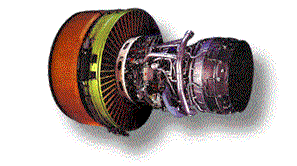
While lift depends on the shape of the wing airfoil, thrust largely depends on the aircraft's propulsion system. The propeller and engine are the two most important elements in generating thrust. Propellers are curved blades that generate thrust in much the same way as a wing produces lift. The blades strike the air at a low angle of attack.
Advanced propellers can change the angle of attack to produce the maximum degree of thrust. These advanced variable pitch propellers can be set fine for full power at low speeds, which is needed for takeoff. They can also be set coarse for high forward speeds with reduced engine revolutions. Propellers on small general aviation aircraft provide adequate thrust with just a light-piston engine. Heavier planes, however, have to rely on more powerful turbine engines for thrust.
Jet engines power most modern large scale aircraft. The process by which a jet engine operates can best be summarized by "suck, squeeze, bang, blow." First, air is drawn into the intake (suck) and compressed (squeeze), which leads to a rise in air pressure. Fuel is then added and burned in a combustion chamber (bang). Combustion imparts heat on the air which causes it to expand rapidly and produce a high speed, hot airflow.
The air then flows through a turbine, which resembles a fan. The high speed air turns the turbine blades which in turn, turn a shaft. The shaft is connected to the compresser. In this way, the turbine extracts a small amount of energy from the gas to power the compressor. The majority of the energy emerages as thrust as the hot air escapes through the exhaust nozzle (blow) and propells the aircraft forward. Jet engines are built with a single-spool design, a compressor at one end of a shaft with a turbine at the other. Hybrid aircraft, like the Harrier Jet, use movable jet nozzles that can point downward to provide thrust for vertical takeoff and move back for conventional, forward flight.

An important development in propulsion design was the turbofan engine. The airflow through these engines is much greater, lowering internal temperatures and dramatically increasing thrust. These engines are also quieter, easier to maintain, and use less fuel. Turbofans, unlike jet engines, are of two-spool or three-spool designs.